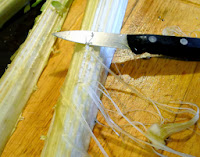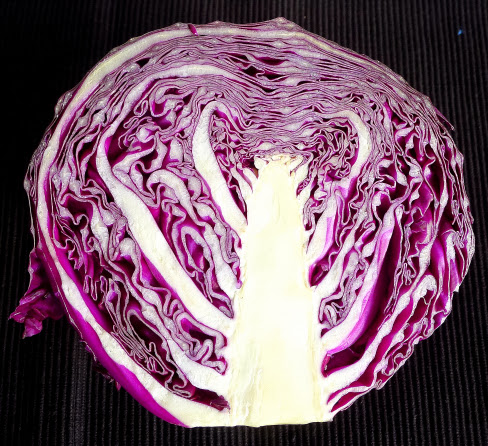 |
| Cardoons for Christmas. (I should have tied a big red bow on it!) |
Not cartoons! Cardoons, a vegetable that turns up at the festive Christmas Eve meal in Spanish homes. Known as cardo in Spanish, the cardoon and its close relative, the artichoke, are thistles. Of the artichoke, it is the flower bud that is eaten; of the cardoon. it is the tall stalks. The first time I ever saw cardoons was in the still-life paintings by Juan Sánchez Cotán (early 17th century). Structurally interesting, but are they edible?
Cardoons are grown in the northern regions of Aragón, La Rioja and Navarra, so that is where this vegetable is most popular at Christmas. But, last week when I spied the stately stalks at a local grocery store, I couldn’t resist having a go.
 |
| Remove strings from stalks. |
Cardoons are delicious in almond sauce; in bechamel sauce with cheese gratin, with clams, wine and parsley in “green sauce.”
Another traditional vegetable at the Spanish Christmas table is col lombarda, red cabbage. Years ago, when I was doing a magazine article about how Spaniards and foreigners celebrate the holidays, I interviewed a Danish woman married to a Spaniard. With Christmas customs, she said, red cabbage was their only point of convergence—traditional for Christmas dinner both in Denmark and at her Madrid mother-in-law’s table. This vegetable is easy to prepare and adds festive color as well. Red cabbage goes especially well with roast pork, venison or goose.
 |
| Red cabbage adds festive color. |
 |
| Cardoons with almond sauce, a side dish for Christmas. |
Cardoons with Almond Sauce
Serves 6-8.
2 lemons
1 ½ tablespoons flour
2-3 pounds cardoons
Salt
3 tablespoons olive oil
½ cup skinned almonds
2 cloves garlic
1 ½ cups chicken stock
Pimentón (paprika) or saffron to finish
Place the juice of 1 lemon in a bowl with about 4 cups of water. Cut the other lemon in half. Stir 1 tablespoon of the flour into ½ cup of water and add it to a large pot with 8 cups of water and 1 ½ teaspoons salt. Squeeze ½ lemon into the pot of water and add the lemon too.
To prepare the cardoons: Discard hard outer stalks. Separate all the stalks from the base. Use a knife or vegetable peeler to remove the strings on the outside of each stalk of cardoon and the thin skin on the inside of the stalks. Rub each stalk as it is peeled with the cut lemon. Cut it into 3-inch pieces and drop them into the bowl with lemon juice.
When the cardoons are prepared, bring the pan of water with the flour and lemon juice to a boil. Add the cardoons, cover and simmer until the cardoons are tender when pierced with a knife, 45 to 60 minutes.
Remove from heat and allow to cool in the cooking liquid. If cooking the cardoons in advance, refrigerate them with the cooking liquid. Drain well before proceeding with the recipe.
Heat the oil in a skillet and fry the almonds and garlic until they are lightly toasted and golden. Skim them out. Set aside a dozen almonds to use as garnish. Place the remainder in a blender with the garlic and some of the chicken stock. Blend until smooth.
Stir the remaining ½ tablespoon of flour into the oil in the skillet and let it cook for 2 minutes. Stir in the drained cardoons, the almond mixture from the blender, the remaining stock and ½ teaspoon salt, or to taste (if stock is salty, take care not to over-salt the sauce).
 |
| A few threads of saffron top the dish. |
Cover and cook the cardoons gently about 30 minutes. Place in a serving bowl and scatter the reserved almonds on top. Serve hot sprinkled with pimentón (paprika) or, for an opulent touch, a few threads of golden saffron.
 |
| Red cabbage with prunes, another good side dish for a holiday meal. |
Lombarda a la Castellana
Red Cabbage, Castillian Style
Red cabbage needs an acid ingredient—wine, citrus or vinegar—to keep its vibrant color while cooking. Adding sweet fruit such as raisins or prunes balances the acidity.
Serves 6.
½ red cabbage (1 ½-2 pounds)
2 tablespoons olive oil
½ cup finely chopped onion
½ cup white wine
4 prunes, pitted and sliced
1 cup water
1 teaspoon salt
Freshly ground black pepper
Cut out and discard the core. Shred the cabbage and set aside.
Heat the oil in a pan and sauté the onion for 3 minutes. Stir in the shredded cabbage and let it sauté 1 minute. Pour over the wine and mix well. Add the prunes, water, salt and pepper. Cover and simmer, stirring occasionally, until cabbage is cooked to taste—20 minutes for slightly crunchy, 40 minutes for very tender.
Good with turkey, goose, pork or venison.
Looking for more about what Spaniards eat for Christmas? Have a look at Kaley’s blog. She’s a young American married to a Spaniard and living in Madrid.
¡Felices Fiestas! Happy Holidays. I hope you enjoy all the wonderful foods during this festive season.

No comments:
Post a Comment